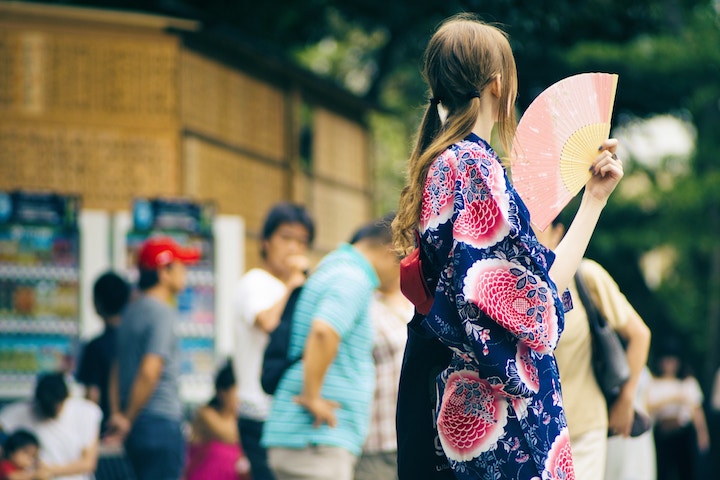
『お盆』は、 Bon festival などの英語もありますが、通常 Obon と呼ばれています。
O は基本的に『ア』か『オゥ 』の発音なので、オゥボン。
ここでは、日本のお盆について、海外の方と話す時に使えるフレーズを載せてみました♡
- Table of contents -
1. お盆って何?
Obon is an important annual event to pay homage to the ancestors.
お盆は、先祖に敬意を表す重要な恒例行事。
It’s a bit like Halloween.
ハロウィンにちょっと似てるよ。
Ancestors’ spirits are considered to be back to this world.
祖先の霊がこの世に帰ってくると考えられてるんだ。
It’s basically the time of family reunion.
基本的には親戚の集まり。
* family reunion: 親族会
2. お盆の期間
Obon period is from August 13th to 16th.
お盆の期間は8月13日から16日。
It depends on the regions.
地域によっても変わるよ。
* region: 地域
It is not technically a public holiday.
厳密には国民の休日じゃない。
* public holiday: 祝日
During this time, however, many offices shut down.
だけど、この期間は業務を停止するオフィスも多い。
* shut down: 閉鎖する
A lot of people take a brief summer break.
短い夏休みを取る人もたくさんいる。
* 夏休みは summer vacation の方が一般的。短いお休みは break なので、この場合は summer break。
4. 帰省
Most people take off to their hometowns.
ほとんどの人が帰省するよ。
The Shinkansen, planes, and highways are all extremely crowded.
新幹線、飛行機、高速道路、全てがとても混んでる。
Japanese are least likely to take their full annual leave.
日本人は、年休をフルに取ることをあまりしない。
* annual leave: 年次休暇
So, short holidays get super busy.
だから、短期休暇はすごく混む。
5. お墓まいり
We visit our family graves, clean the tombstones, and leave flowers.
家族のお墓を訪れて、暮石を掃除し、お花を供えるんだ。
* tombstone: 墓石
In Nagasaki, it’s common to enjoy handheld fireworks in the cemetery.
長崎では、墓地で手持ち花火を楽しむのが慣習だよ。
* handheld fireworks: 手持ちで行う花火
6. 仏壇
People place a lot of kind of fruit and sweets in front of the Buddhist home altar as offerings.
仏壇の前にはお供え物として、たくさんの種類のフルーツやお菓子をおく。
* the Buddhist home alter: 仏壇
The Buddha has a sweet tooth!
仏様は甘いもの好き!
* sweet tooth: 甘党
Faux cucumber horses and eggplant cows are the transportation for the ancestors.
フェイクなきゅうりの馬とナスの牛はご先祖様の交通手段。
* faux: 偽の
The horse represents a quick arrival, the cow represents a slow departure.
馬は早く来てね!牛は、ゆっくりしてってね!の意味。
You can use disposal wooden chopsticks to make legs.
脚は、割り箸で作れるよ。
* 割り箸: disposal wooden chopsticks
7. 迎え火
August 13th, we welcome the spirits of ancestors by making mini fire at the entrances.
13日に玄関で火を焚いて祖先の霊を歓迎します。
It’s also common to hang paper lanterns.
提灯を吊るすこともポピュラー。
* paper lantern: 提灯(ちょうちん)
Lanterns are safer than fire, anyway.
提灯はやっぱり火より安全だしね。
8. 送り火
August 16th, we make fire again to send off the souls.
8月16日の夕方に送り火を焚いて霊を送ります。
灯籠流し
Toro Nagashi means floating lanterns.
灯籠流しは提灯を浮かべるって意味。
To means light, ro means basket.
to は灯、roは籠。
This ritual is held all over Japan.
この儀式は、日本全国で行われています。
* ritual: 儀式
Paper lanterns on the water escort the spirits back to the world they belong.
水の上の紙提灯は、霊を彼らの世界へエスコートするんだよ。
The view of thousands of glowing lanterns is chillingly beautiful.
光を放つ何千もの提灯はゾッとするほど美しい。
In Asakusa, you can even purchase your own lantern and release it on the Sumida river.
浅草では、自分の提灯を買って隅田川に流すこともできるよ。
長崎の精霊流し
In Nagasaki, Obon is from August 14th to 15th.
長崎ではお盆は8月14日から15日。
Shoryo Nagashi, spirit boat procession, is held in Nagasaki on the last day of Obon.
精霊流しはお盆の最終日に長崎で行われます。
A lot of people are confused this with Toro Nagashi.
たくさんの人がこれを灯篭流しと勘違いしています。
But Shoryo Nagashi is basically a decorated boat parade downtown, not in the river.
だけど、精霊流しは基本的に川ではなく市街地でのボート山車パレード。
Sounds solemn though, actually the festival is rather chaotic.
厳粛な感じがするけど、お祭りは実は無秩序。
* solemn: 厳かな、荘厳な
The explosions of a tremendous amount of firecrackers echo everywhere!
大量の爆竹の爆発音が至るところに響き渡る!
* firecracker: 爆竹
Earplugs are must haves.
耳栓は必需品。
* earplugs: 耳栓
Some boats cost a couple of million yen to make, though,
船の中には作るのに2、3百万かかるものもあるんだけど、
all boats are immediately torn down right after the parade.
全部のボートはパレードの直後に壊されるよ。
京都、五山の送り火
Gozan no Okuribi, the famous Daimonji bonfire at Arashiyama, marks the end of Obon.
五山の送り火、有名な嵐山の大文字焼き(かがり火)はお盆の終わりの印。
Daimonji is followed by “Myoho”, “Funagata”, “Hidari-Daimonji” and “Toriigata”.
大文字の後は、妙、法、船の形、(向かって左側に見える)左大文字、鳥居の形が続きます。
9. 盆踊りの会場
Bon dance is a style of dancing performed during Obon.
『盆踊り』はお盆の期間に踊るダンスです。
It was originally designed to calm the ancestors’ spirits.
もともとは先祖の霊をなだめるために作られたもの。
People gather at parks, shrines or temples and dance with music.
公園や、神社、お寺に集まって、音楽に合わせて踊ります。
Most of them are wearing yukata.
ほとんどの人が夏の着物、浴衣を着てる。
Yukata is a light kimono worn in summer.
浴衣は夏に着る軽い着物。
There are a lot of food stalls.
食べ物の屋台がたくさんあるよ。
* stall: 屋台
You can get Japanese style savory pancakes, fried noodles, octopus balls and more!
お好み焼、焼きそば、たこ焼きなんかが買えるよ!
Also sweets like candy apples, snow cone, cotton candy, and chocolate dipped bananas.
りんご飴、かき氷、綿あめ、チョコバナナみたいなスイーツも。
Game booths are there, too!
ゲームブースもある!
Kids can enjoy throwing darts, cork shooting, super-ball, balloon yo-yo, and goldfish scooping.
子供たちは、ダーツ、射的、スーパーボールすくい、風船ヨーヨーすくい、金魚すくいで遊べるよ。
さだまさしさんの『精霊流し』には、密かに爆竹音が入っているそうです(^^)
こちらもどうぞ ↓
子供の遊び、英語では? おままごと、おにごっこ、シャボン玉など
ちょこっと英会話 ↓
Have a great summer!
素敵な夏を!